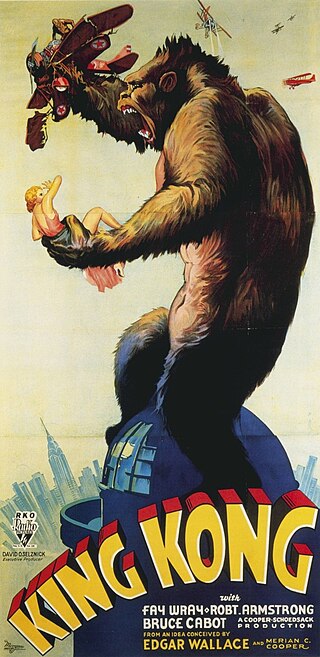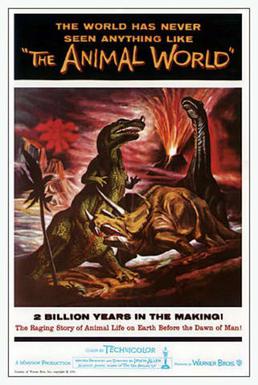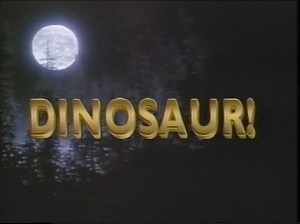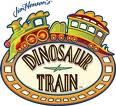Related Research Articles

King Kong is a 1933 American pre-Code adventure horror monster film directed and produced by Merian C. Cooper and Ernest B. Schoedsack, with special effects by Willis H. O'Brien. Produced and distributed by RKO Radio Pictures, it is the first film in the King Kong franchise. The film stars Fay Wray, Robert Armstrong and Bruce Cabot. In the film, a giant ape dubbed King Kong captured from Skull Island attempts to possess a beautiful young woman.

Willis Harold O'Brien, known as Obie O'Brien, was an American motion picture special effects and stop-motion animation pioneer, who according to ASIFA-Hollywood "was responsible for some of the best-known images in cinema history," and is best remembered for his work on The Lost World (1925), King Kong (1933), The Last Days of Pompeii (1935) and Mighty Joe Young (1949), for which he won the 1950 Academy Award for Best Visual Effects.

The Valley of Gwangi is a 1969 American fantasy Western film produced by Charles H. Schneer and Ray Harryhausen, directed by Jim O'Connolly, written by William Bast, and starring James Franciscus, Richard Carlson, and Gila Golan.

The Son of Kong is a 1933 American Pre-Code adventure monster film produced by RKO Pictures. Directed by Ernest Schoedsack and featuring special effects by Willis O'Brien and Buzz Gibson, the film stars Robert Armstrong, Helen Mack and Frank Reicher. The film is the sequel to King Kong, being released just nine months after and is the second entry of the King Kong franchise.

Skull Island is the name most often used to describe a fictional island that first appeared in the 1933 film King Kong and later appearing in its sequels, the three remakes, and any other King Kong-based media. It is the home of the eponymous King Kong and several other species of creatures, mostly prehistoric and in some cases species that should have been extinct long before the rise of mammalian creatures, along with a primitive society of humans.

The Lost World is a 1925 American silent fantasy giant monster adventure film directed by Harry O. Hoyt and written by Marion Fairfax, adapted from Arthur Conan Doyle's 1912 novel of the same name.

Anonymous Rex is a 2004 science fiction film directed by Julian Jarrold and starring Sam Trammell and Daniel Baldwin. The film was produced as a "backdoor pilot" for an unproduced television series of the same name. It is based on the novel Casual Rex by Eric Garcia. It was aired on Sci Fi Channel.

The Missing Link is a 1980 French–Belgian adult animated comedy film written and directed by Picha. Though it was not as successful as Picha's previous film, it was entered into the 1980 Cannes Film Festival.

Tyrannosaurus rex is unique among dinosaurs in its place in modern culture; paleontologist Robert Bakker has called it "the most popular dinosaur among people of all ages, all cultures, and all nationalities". Paleontologists Mark Norell and Lowell Dingus have likewise called it "the most famous dinosaur of all times." Paleoartist Gregory S. Paul has called it "the theropod. [...] This is the public's favorite dinosaur [...] Even the formations it is found in have fantastic names like Hell Creek and Lance." Other paleontologists agree with that and note that whenever a museum erects a new skeleton or bring in an animatronic model, visitor numbers go up. "Jurassic Park and King Kong would not have been the same without it." In the public mind, T. rex sets the standard of what a dinosaur should be. Science writer Riley Black similarly states, "In all of prehistory, there is no animal that commands our attention quite like Tyrannosaurus rex, the king of the tyrant lizards. Since the time this dinosaur was officially named in 1905, the enormous carnivore has stood as the ultimate dinosaur."

The Ghost of Slumber Mountain is a 1918 film written and directed by special effects pioneer Willis O'Brien, produced by Herbert M. Dawley, and starring both men. It is the first film to show live actors and stop-motion creatures together on the screen and is often cited as a trial run for The Lost World. An advertising tagline for the film read "These giant monsters of the past are seen to breathe, to live again, to move and battle as they did at dawn of life." [sic] The film attracted the interest of Watterson R. Rothacker, founder of the Industrial Motion Picture Company, who was so impressed by the film's special effects, he joined forces with O'Brien to create the dinosaurs of The Lost World (1925), a classic that advanced the development of special effects techniques.

T-Rex: Back to the Cretaceous is a 1998 American educational adventure film shot for the IMAX 3D format. The film is directed by Brett Leonard. Executive producer/co-writer Andrew Gellis and producers Antoine Compin and Charis Horton also make up the production team. Liz Stauber and Peter Horton star, alongside Kari Coleman, Tuck Milligan, and Laurie Murdoch. When a museum accident transports teenager Ally Hayden on an adventure back in time, she explores the terrain and territory of life-sized dinosaurs, even during a nose-to-nose encounter with a female Tyrannosaurus. The film is among the few IMAX films that are considered "pure entertainment", though it still is considered rather educational by the mainstream audience.

Stegosaurus is one of the most recognizable types among cultural depictions of dinosaurs. It has been depicted on film, in cartoons, comics, as children's toys, as sculpture, and even was declared the state dinosaur of Colorado in 1982. Stegosaurus is a subject for inclusion in dinosaur toy and scale model lines, such as the Carnegie Collection.

The Magic School Bus In the Time of the Dinosaurs is the sixth book in Joanna Cole and Bruce Degen's The Magic School Bus series.

The Animal World is a 1956 American documentary film that was produced, written and directed by Irwin Allen. The film includes live-action footage of animals throughout the world, along with a ten-minute stop motion animated sequence about dinosaurs.

The Last Dinosaur is a 1977 Japanese/American tokusatsu co-production, co-directed by Alexander Grasshoff and Tsununobu Kotani, and co-produced by Japan's Tsuburaya Productions and Rankin/Bass Productions. The picture was filmed at Tsuburaya Studios in Tokyo and on location in the Japanese Alps. The film was intended for a U.S. theatrical release, but failed to find a distributor and ended up as a television film, airing on ABC on February 11, 1977 in an edited 92-minute run time. The film was eventually picked up for overseas markets by Cinema International Corporation, where it was released in the unedited 106-minute version as a double feature in the U.K. with the edited version of Sorcerer. Toho also picked up distribution rights to The Last Dinosaur in Japan for a theatrical release utilizing the unedited 106-minute version in English with Japanese subtitles, and later the film debuted on Japanese television dubbed in Japanese.

Dinosaur! is a 1985 American television documentary film about dinosaurs. It was first broadcast in the United States on November 5, 1985, on CBS. Directed by Robert Guenette and written by Steven Paul Mark, Dinosaur! was hosted by the American actor Christopher Reeve, who some years before had played the leading role of Superman.
Teessaurus Park is a 10 acre urban grassland recreational area and sculpture park opened in 1979 in the Riverside Park light industrial estate, Middlesbrough, on the southern bank of the River Tees. It was built on a former slag heap in what was the Ironmasters district and represents, without any irony, the iron and steel industry that used to exist on the site and in the area. The park has its own small car park and has become something of a nature reserve. The route of the Teesdale Way passes through the park.

Dinosaur Train is an animated television series aimed at preschoolers ages 3 to 6 and created by Craig Bartlett, who also created Nickelodeon's Hey Arnold!. The series features a Tyrannosaurus rex named Buddy who, together with the rest of his family, who are all Pteranodons, takes the Dinosaur Train to explore his time period, and have adventures with a variety of dinosaurs. It is co-produced by The Jim Henson Company in association with the Infocomm Media Development Authority, Sparky Animation, FableVision, Snee-Oosh, Inc., Reel FX, and Sea to Sky Entertainment. As of September 2018, PBS Kids had ordered 11 more episodes, taking the total number of episodes to 100. A film based on the series from Universal Pictures and Universal 1440 Entertainment titled, Dinosaur Train: Adventure Island premiered on April 12, 2021.

Jurassic Park Arcade is a 2015 light gun arcade game developed by Raw Thrills. The game is based on the original trilogy of the Jurassic Park film series.

Jurassic Park, later also referred to as Jurassic World, is an American science fiction adventure media franchise. It focuses on the cloning of dinosaurs through ancient DNA, extracted from mosquitoes that have been fossilized in amber. The franchise explores the ethics of cloning and genetic engineering, and the morals behind de-extinction.
References
- ↑ Senn, Bryan (September 3, 2015). Golden Horrors: An Illustrated Critical Filmography of Terror Cinema, 1931-1939. McFarland. ISBN 978-1-4766-1089-4.
- ↑ Morton, Ray (2005). King Kong: The History of a Movie Icon from Fay Wray to Peter Jackson. Hal Leonard Corporation. ISBN 978-1-55783-669-4.
- ↑ Erb, Cynthia (April 10, 2009). Tracking King Kong: A Hollywood Icon in World Culture. Wayne State University Press. ISBN 978-0-8143-3742-4.
- ↑ LoBrutto, Vincent (August 2, 2019). The Art and Craft of Motion Pictures: 25 Movies to Make You Film Literate. Bloomsbury Publishing USA. ISBN 978-1-4408-3919-1.
- ↑ "Modelo de King Kong original vai a leilão". www.dn.pt (in European Portuguese). November 22, 2009. Retrieved October 3, 2023.
- ↑ Pettigrew, Neil, The Stop-Motion Filmography, McFarland and Co., Inc., 1999, p. 161 and again p. 470
- ↑ DVD 2005.
Sources
- Goldner, Orville; Turner, George E. (1975). The making of King Kong. New York: Ballantine Books. ISBN 978-0-904208-70-2 – via Internet Archive. contains information about, and stills from, this unfinished film
- Peter Jackson, Michael Pellerin (producers) (2005). Willis O'Brien and Creation. RKO Production 601: The Making of Kong, The Eighth Wonder of the World (documentary). Warner Home Video.